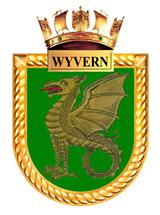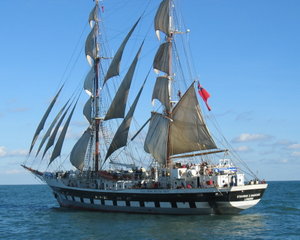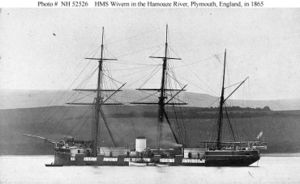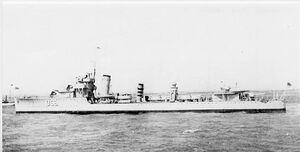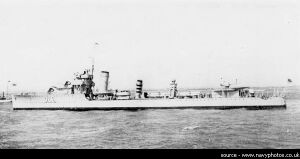USS Wyvern
Legacy of the Wyvern
HMS Wyvern, Brigantine (1712-1736)
The earliest namesake of the USS Wyvern is found in the records of 18th century Earth. The first recorded use of the name belonged to the HMS Wyvern, a brigantine (the shortened expression is brig) vessel. This class of vessel is equipped both for sailing and rowing, swifter and more easily maneuvered than larger ships, and hence employed for purposes of piracy, espionage, reconnoitering, etc., and as an attendant upon larger ships for protection, landing purposes, etc. The earlier days the brig was a vessel with two masts square-rigged like a ship's fore- and main-masts, but carrying also on her main-mast a lower fore-and-aft sail with a gaff and boom. In later times, while still having only two masts, it carried square sails on her fore-mast, and, as to its after-mast, it was like that of the main-mast of a schooner, that is to say, fore-and-aft-rigged.
In the 18th and the earlier part of the 19th centuries, a sloop-of-war was a small sailing warship (also known as one of the escort types) with a single gun deck that carried anything up to eighteen cannon. As the rating system covered all vessels with 20 guns and above, this meant that the term sloop-of-war actually encompassed all the unrated combat vessels including the very small gun-brigs and cutters. In technical terms, even the more specialized bomb vessels and fireships were classed as sloops-of-war, and in practice these were actually employed in the sloop role when not carrying out their specialized tasks.
The first three-masted sloops appeared during the 1740s, and from the mid-1750s most new sloops were completed with a ship (three-masted) rig. However, in the 1770s the two-masted sloop re-appeared in a new guise as the brig sloop. The successor to the former slow sloops, the brig sloops had two masts while the ship sloop continued to have three (since a brig is a two-masted, square-rigged vessel and a ship a three- or more-masted square-rigger, though invariably of 3 only in that period).
The Brigantine or Brig was a type of ship used in large numbers, both as a Merchant vessel and as a Naval Ship. It carried 16 guns and was rigged for speed, having both top gallant sails and royals. These ships were used by Navies of the World for scouting and reconnaissance duties. They were used to track down ships of an enemy navy. Many of the Brigs of the late 18th century could carry sweeps for maneuvering in still weather. In 1814 the British Navy had 71 brigs of various types carrying 10 to 16 guns.
Dimensions:
- Length: 110-ft
- Beam: 28-ft
- Draft: 16-ft
- Armament: 16 50-pound cannons
- Crew: 100 to 120
The Brig HMS Wyvern was a typical ship of the Brig class; she saw service from February 24, 1712 until her sinking in 1736, during a storm off the tip of South Africa. The ship was under the command of Captain John Blackthorn. In 2405 the wreckage of the HMS Wyvern was raised and restored. She is currently an living history museum piece.
HMS Wyvern, Scorpion Class Schooner/Battleship (1862-1922)
The two ships of the Scorpion class, HMS Scorpion and HMS Wivern, were the first warships ever which were built to the order of a foreign country and subsequently acquired for service in the Royal Navy.
In 1862 a contract was placed with Laird & Son Co by Captain James D. Bulloch, a naval agent for the Confederate States of America, for two double-turreted warships designed for ramming attacks at a cost of £93,750 each, exclusive of armament and ammunition. They were intended, together with other warships, to break the Federal blockade of Confederate coastal cities, to combat the Federal fleet, and possibly to attack Federal coastal cities. In January 1863 the Foreign Secretary, Lord John Russell, notified Bulloch that the ships would be prevented from sailing if they were doing so to form part of the fleet of a nation currently at war. This was mostly because whilst the British government was reasonably supportive of the South they saw no future in fighting a drawn out war with the North. This knowledge and the successes of Union arms in 1863 enabled Northern representatives in England to threaten war if the rams were not seized.
Bulloch therefore arranged for some French bankers to purchase the ships, nominally on behalf of the Egyptian government, it is assumed with the intention of transferring them to the Confederate flag once they were at sea. Her true ownership was to be concealed by the fiction that she was being constructed as the Egyptian warship El Monassir. The Khedive of Egypt was attempting to acquire warships, so this appeared plausible.
She was to have been named Mississippi upon delivery to the Confederates. She would have been superior to all but one of the United States' Navy warships, and thus represented a most serious danger to the Union's control of the seas. However, effective Federal diplomacy prevented the emergence of this threat. Russell, being in contact with the Federal authorities, arranged that the ships should be seized by Britain.
The British government seized the pair of ironclads in October 1863, a few months after their launch and before they could be completed. In early 1864, both were purchased for the Royal Navy, receiving the new names Scorpion and Wivern (Wyvern). The legality of this seizure was seriously disputed, but the British government had already been somewhat embarrassed by the activities of the Alabama, a ship also built by Laird Son & Co and operated as a Corsair by the confederate forces.
In order to overshadow discussions as to the legality of their action, the British government purchased the ships for £30,000 in excess of the contract price. HMS Wivern was a 2750-ton ironclad turret ship built at Birkenhead, England, one of two sister ships secretly ordered from the Laird & Sons shipyard by the Confederate States of America government in 1862.
Completed in October 1865, Wivern was assigned to the Channel Fleet until 1868. After a refit that reduced her sailing rig from a barque to a schooner, the Wivern served briefly as a coastguard ship based at Hull and then went into reserve. In 1870 Wivern was brought back into active service and dispatched to Hong Kong. She remained in Hong Kong until sold for scrap in 1922, having been reduced to harbor duties from 1904.
One of her commanding officers was Captain Hugh Talbot Burgoyne, VC who was later appointed the commanding officer of HMS Captain. The Captain was also a twin turret ship.
General Characteristics:
- Ordered for Confederate Navy: 1862
- Laid down: April 1862
- Launched: August 29, 1863
- Seized by British Government: October 1863
- Completed: October 10, 1865
- Broken up: 1922
- Specification
- Displacement: 2,751 tons
- Length: 224 ft 6 inches
- Beam: 42 ft 4 inches
- Draught: 15ft 6 inches light, 17 ft deep load
- Engine: Lairds horizontal direct-acting
- Propulsion: horizontal direct acting engine, one shaft, 4 boilers, 1450 IHP
- Speed under power: 10.5 knots
- Rig: Ship-rig with tripod masts
- Complement: 153
- Armament: 4 × 9 in (228 mm) (2 × 2) muzzle-loading rifles
- Armor: Belt 4.5 inches, Bow 3inches and Stern 2 inches, Turret faces 10 inches, sides 5 inches
HMS Wyvern D66, Modified W Class Destroyer (1919- 1947)
HMS Wyvern was launched in April 1919 and was part of the 16th Destroyer Flotilla. Wyvern was sold in 1947 after many trips around the world.
The HMS Wyvern saw service in the Mediterranean Fleet. At this time the ship was not a submarine detecting Destroyer, but at a later date, mid-1930’s she was converted, as was most of the old class of Destroyers. Some were considered unsuitable as they were too old. All destroyers from 1928 forward were built with the detection gear already installed.
The USS Wyvern served with the Mediterranean Fleet in the 4th Destroyer Squadron of nine ships in the 16th Flotilla. Two (as called) Divisions of 4 ships with one Destroyer with a Captain aboard in charge of the Flotilla. At that time there were four Flotillas serving in Malta. After a Flotilla had served 2 years 4 months or so, it was sent back to England to pay off and all crew left the ship which was replaced by a new one which was sent aboard after a refit in the home ports. Therefore, at those times only 3 Flotillas were on station.
Exercises with the Fleet were War Maneuvers in which, instead of part of the watch, the whole watch was on duty with extra lookouts and certain guns manned. That was when the two parts of the Fleet met in mock battle. (Red and Blue). After all exercises had been completed the Fleet dispersed. Most ships went to various places to anchor and give leave. We had 2 Aircraft Carriers with the Fleet and these also took part in the maneuvers.
Whilst at Malta, the Fleet put to sea for gunnery practice. Destroyers built from 1927 also had more modern Directors to improve the efficiency of firing the guns and guns of a uniform size - 4.7". Gunnery improved on as time went on - more range.
War Record World War II
- On March 13, 1941 the USS Wyvern was assigned as an escort for Convoy SL.114 through the Mediterranean Sea. She engaged and is believed to have sunk two enemy U-Boats during that convoy action.
- On February 22nd, 1943 whilst escorting convoy KMS.8, Flower class corvette HMS Weyburn strikes a mine laid by U-118 and sinks 4 miles W of Cape Spartel at 35 48N 06 02W. The HMS Wyvern is damaged by the Weyburn’s exploding depth charges whilst attempting to rescue survivors.
- On March 14, 1945, U714 was depth charged and sank by the South African Frigate HMSAS Natal and the HMS Wyvern on the 14th March 1945 with loss of all 50 crew members.
One of the vessel’s commanding officers was Captain Sydney George Cribb who died 3rd January 1923 and was buried at Kalkara Naval Cemetery. From July 1939 the HMS Wyvern was commanded by Captain Reginald Gregory Haines
General Specifications:
- Shipyard: James Samuel White & Co. Ltd., Cowes
- Laid down 19.08.1918
- Launch 16.04.1919
- Construction time: 0y 7m 28d
- Scrapped: 1948
- Type: Torpedo destroyer, modified class W
- Dimensions: 300 (p.p.), 312 (o.a.) x 29.5 x 9 feet (mean) draught.
- Displacement 1300 tons average
- Armament 4-4.7 inch (Dir. Con.), 2-2 pdr. Pom-poms. Tubes: 6 in two triple mountings.
- Propulsion Brown-Curtis AG turbines (Whitehall and perhaps one or two others: Parsons), Designed S.H.P. 27,000, 2 screws. Boilers: Yarrow (White's: White-Forster)
- Max. Speed 34 kts
- Bunkerage Oil: about 350/ 320 tons
- Crew 127
More to come
Wyvernc.jpg Wyvern_ironclad.jpg USS_Wyvern_WWII-3.jpg (small) Wyvern1b-_wwii.jpg The_HMS_Wyvern_Brig_Restored.jpg
